By the 435 anniversary of the beginning (1581) of the Siberian campaign of Ermak
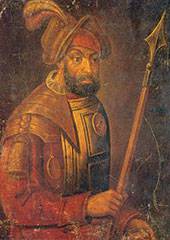 Ermak Timofeevich - is perhaps one of the mysterious personalities in stories. His biographical data are not known for certain, as are the circumstances of the campaign he led to Siberia. They serve as material for many mutually exclusive hypotheses, but there are also generally accepted facts about Ermak’s biography, and such moments of the Siberian campaign as the majority of researchers do not have any fundamental differences. The history of the Siberian campaign of Yermak was occupied by the major pre-revolutionary scientists N.M. Karamzin, S.M. Soloviev, N.I. Kostomarov, S.F. Platonov. The main source on the history of the conquest of Siberia by Yermak is the Siberian chronicles (Stroganov, Esipovskaya, Pogodinskaya, Kungurskaya and some others), carefully studied in the works of G.F. Miller, PI Nebolsina, A.V. Oxenova, P.M. Golovacheva S.V. Bakhrushin, A.A. Vvedensky and other prominent scientists.
Ermak Timofeevich - is perhaps one of the mysterious personalities in stories. His biographical data are not known for certain, as are the circumstances of the campaign he led to Siberia. They serve as material for many mutually exclusive hypotheses, but there are also generally accepted facts about Ermak’s biography, and such moments of the Siberian campaign as the majority of researchers do not have any fundamental differences. The history of the Siberian campaign of Yermak was occupied by the major pre-revolutionary scientists N.M. Karamzin, S.M. Soloviev, N.I. Kostomarov, S.F. Platonov. The main source on the history of the conquest of Siberia by Yermak is the Siberian chronicles (Stroganov, Esipovskaya, Pogodinskaya, Kungurskaya and some others), carefully studied in the works of G.F. Miller, PI Nebolsina, A.V. Oxenova, P.M. Golovacheva S.V. Bakhrushin, A.A. Vvedensky and other prominent scientists.The question of the origin of Ermak is controversial. Some researchers deduce Yermak from the Perm fiefdoms of the Stroganov salt-miners, others from Totemsky district. G.E. Katanaev assumed that at the beginning of the 80's. XVI century at the same time acted three Ermak. However, these versions look unreliable. At the same time, the patronymic Yermak - Timofeevich is known for sure, “Yermak” can be a nickname, a contraction, or a distortion of such Christian names as Yermolai, Yermil, Yermey, etc., or maybe an independent pagan name.
There is very little evidence on the life of Yermak before the Siberian campaign. Yermak was also credited with participation in the Livonian War, robbery and robbery of the royal and merchant ships passing along the Volga, but reliable evidence of this was also not preserved.
The beginning of the campaign of Yermak to Siberia is also the subject of numerous disputes of historians, which is conducted mainly around two dates - September 1 of 1581 and 1582. Supporters of the campaign began in 1581 were S.V. Bakhrushin, A.I. Andreev, A.A. Vvedensky, in 1582 - N.I. Kostomarov, N.V. Shlyakov, G.E. Katanaev. The most reasonable date is considered to be 1 September 1581.
The scheme of the Siberian campaign Ermak. 1581 - 1585
A completely different point of view was expressed by V.I. Sergeyev, according to whom, Yermak set out on an expedition already in September of 1578. At first, he descended on Struga down the river. Kame, climbed its tributary r. Sylve, then returned and wintered near the mouth of the river. Chusovoy. Swimming on the river. Sylve and wintering on the river. Chusovoy were a kind of training, which gave the ataman the opportunity to rally and test the squad, to accustom her to actions in new, difficult conditions for the Cossacks.
Russian people tried to conquer Siberia long before Ermak. So in 1483 and 1499. Ivan III sent military expeditions there, but the harsh land remained unexplored. The territory of Siberia of the XVI century was extensive, but at the same time it was little populated. The main occupations of the population were cattle breeding, hunting, and fishing. Somewhere along the banks of the rivers, the first centers of agriculture appeared. The state with the center in Isker (Kashlyk — in different sources is called differently) united several indigenous peoples of Siberia: the Samoyeds, the Ostyaks, the Voguls, and all of them were ruled by the “fragments” of the Golden Horde. Khan Kuchum from the Sheibanids clan, who ascended to Genghis Khan himself, seized the Siberian throne in 1563 and headed for ousting the Russians from the Urals.
In 60-70-ies. In the 16th century, the Stroganov merchants, industrialists and landowners received from Tsar Ivan Vasilyevich the Terrible possession in the Urals, and they were also given the right to hire military people in order to prevent Kuchumites from attacking. The Stroganovs invited a detachment of free Cossacks led by Ermak Timofeevich. At the end of 70-x - the beginning of 80-x. In the 16th century, the Cossacks went up the Volga to the Kama, where they were met by the Stroganovs in Kredin (Oryol-Gorodok). The number of squad Ermak, arrived at the Stroganovs, was 540 people.
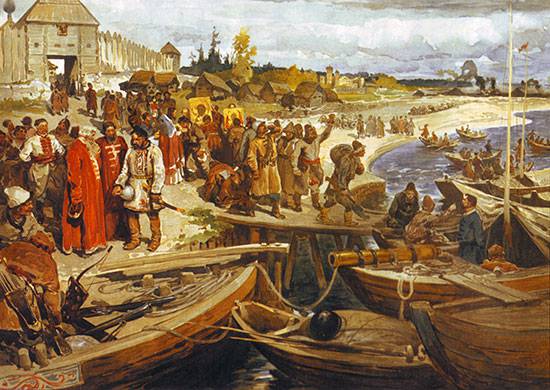
Hike Ermak. Artist K. Lebedev. 1907
Before the campaign, the Stroganovs supplied Yermak and his warriors with everything they needed, starting with gunpowder and ending with flour. Stroganov shops were the basis of the material base squad Ermak. By the march to the Cossack ataman, the Stroganovs were dressed up. The squad was divided into five regiments, headed by the elected captain. The regiment was divided into hundreds, those, in turn, into fifty and dozens. The brigade had regimental clerks, trumpeters, surnachy, tubers and drummers. There were also three priests and a runaway monk who sent liturgical rites.
In the army Ermak reigned the strictest discipline. He ordered that no one, “through fornication, or other sinful deeds, incurred the wrath of God,” who violated this rule, was put in prison for three days “in iron.” In the squad of Ermak, following the example of the Don Cossacks, severe punishments were laid for disobedience to the heads and escape.
Having gone hiking, the Cossacks on pp. Chusovoy and Serebryanka crossed the path to the Ural Mountains, further from r. Serebryanka to r. Tagil walked through the mountains. The passage of Yermak through the Ural range was not easy. Each plow could lift up a man with a load to 20. Struga greater carrying capacity on small mountain rivers could not be used.
Next Ermak swam on p. Barancha, and then moved down the river. Tagil, after - on r. Tour The Cossacks successfully repelled the attacks of Kuchum and captured a number of Siberian cities.
The onset of Ermak on the river. The tour forced Kuchum to gather his strength as much as possible. The chronicles do not give an exact answer to the question about the number of troops, they only report on the "great multitude of the enemy." A.A. Vvedensky wrote that the total number of subjects of the Siberian khan was approximately 30 700 people. Mobilizing all men capable of wearing weapon, Kuchum could expose more than 10-15 thousand soldiers. Thus, he had multiple numerical superiority.
Simultaneously with the collection of troops Kuchum ordered to strengthen the capital of the Siberian Khanate Isker. The main forces of the Kuchumov cavalry under the command of his nephew Tsarevich Mametkul were advanced to meet Yermak, flotilla which by August 1582, and according to some researchers, no later than in the summer of 1581, reached the confluence of the river. Tours in the river Tobol. An attempt to detain the Cossacks near the mouth of the river. Tours failed. Cossack plows entered the river. Tobol and began to descend along its course. Several times Yermak had to land and attack the Kuchumlans. Then there was a major bloody battle near the Babasanovsky Yurts.
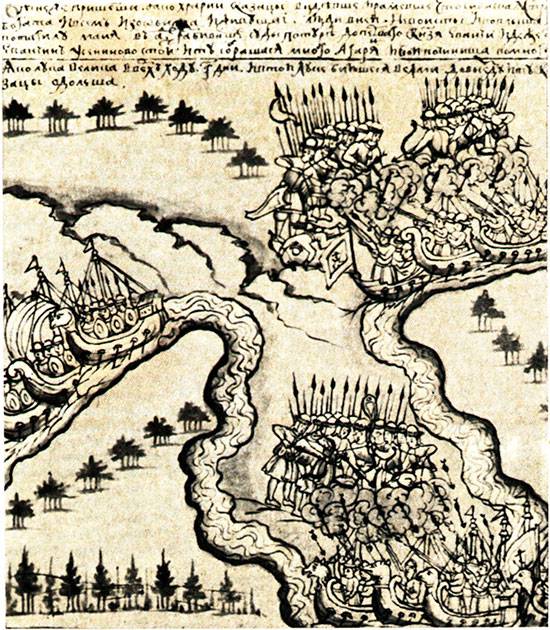
Promotion of Ermak on the Siberian rivers. Drawing and text to the "History of Siberian" S. Remezov. 1689
Fights on the river. Tobol showed the advantages of Ermak’s tactics over the enemy’s tactics. The basis of this tactic was fire attack and combat on foot. The salvos of Cossack pischals inflicted considerable damage on the enemy. However, do not exaggerate the value of firearms. From the food of the end of the XVI century, one shot could be made in 2-3 minutes. Kuchumlyane mostly were not armed with firearms, but they were familiar. However, the fight on foot was Kuchum's weak side. Entering into a clash with the crowd, in the absence of any military arrangements, Kuchum residents suffered defeat after defeat, despite considerable superiority in manpower. Thus, the successes of Ermak were achieved by combining the fire of squeals and hand-to-hand combat with the use of cold weapons.
After Ermak left p. Tobol and began to climb up the river. Tavda, which, according to some researchers, was done with the aim of separation from the enemy, respite, and search for allies before the decisive battle for Isker. Climbing up the river. Tavda approximately 150-200 versts, Ermak made a stop and returned to r. Tobol. On the way to Isker, he was taken. Karachin and Atik. Having established itself in Karachin, Yermak found itself on the immediate approaches to the capital of the Siberian Khanate.
Before the storming of the capital, Yermak, according to the chronicle sources, gathered a circle where the likely outcome of the upcoming battle was discussed. Supporters of the retreat pointed to the many Kuchumlian and small number of Russians, but the opinion of Ermak was the need to take Isker. In his decision, he was firm and supported by many of his associates. In October, 1582, the city of Ermak, launched an assault on the fortifications of the Siberian capital. The first assault was crowned with failure; about October 23 Yermak struck again, but the Kuchumlians beat off the assault and made a sally, which turned out to be disastrous for them. The battle under the walls of Isker once again showed the advantages of the Russians in hand-to-hand combat. Khan's army was defeated, Kuchum fled from the capital. October 26 1582 Yermak and his team entered the city. The capture of Isker was the pinnacle of Yermak's success. Indigenous Siberian peoples expressed readiness for an alliance with the Russians.
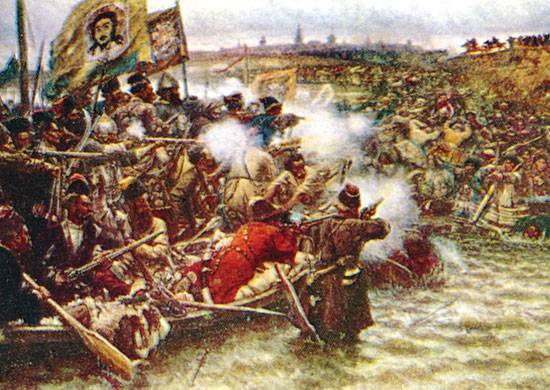
Conquest of Siberia by Yermak. Artist V. Surikov. 1895
After the capture of the capital of the Siberian Khanate, the main opponent of Ermak remained Tsarevich Mametkul, who, having quite good cavalry, made raids on small Cossack groups, which constantly disturbed Ermak's team. In November-December 1582, the prince destroyed the Cossack detachment, who went fishing. Yermak was struck back, Mametkul ran, but after three months he reappeared in the vicinity of Isker. In February, 1583, Mr. Yermaku, was informed that the prince’s camp was divided into r. Wag in 100 versts from the capital. Ataman immediately sent there the Cossacks who attacked the army and captured the prince.
In the spring of 1583, the Cossacks made several trips along the Irtysh and its tributaries. The most distant was a trip to the mouth of the river. The Cossacks on Strug reached the city of Nazym - a fortified town on the river. Ob, and took it. The battle near Nazim was one of the bloodiest.
Losses in battles forced Yermak to send messengers for reinforcements. As evidence of the fruitfulness of his actions during the Siberian campaign, Yermak sent Ivan IV a captive prince and furs.
Winter and summer 1584 passed without major battles. Kuchum was not active, as he was restless inside the horde. Ermak coast of his army and was waiting for reinforcements. The reinforcements arrived in the fall of 1584. They were 500 warriors sent from Moscow under the command of voivode S. Bolkhovsky, not supplied with any ammunition or food. Ermak was put in a difficult position, because hardly prepared the necessary supplies for his people. Hunger began in Isker. People died, S. Bolkhovsky himself died. The situation was somewhat improved by the local residents, who supplied the Cossacks with food from their stocks.
The chronicles do not give the exact number of casualties to the troops of Yermak, however, according to some data, by the time of the death of the chieftain, his squad remained 150 people. The position of Ermak was complicated by the fact that in the spring of 1585, the city of Isker was surrounded by enemy cavalry. However, the blockade was lifted thanks to Yermak’s decisive blow to the enemy’s rate. The liquidation of Isker's entourage was the last combat feat of the Cossack chieftain. Ermak Timofeevich died in the waters of the river. Irtysh during a campaign against Kuchum 6 August 1585 troops that appeared nearby
Summing up, it should be noted that the tactics of the Ermak squad was based on the rich military experience of the Cossacks, accumulated over many decades. Hand-to-hand combat, accurate shooting, strong defense, maneuverability of the squad, the use of the terrain - the most characteristic features of Russian military art of the XVI - XVII centuries. To this, of course, should be added the ability of the ataman Ermak to maintain rigid discipline within the squad. These skills and tactical skills to the greatest extent contributed to the conquest of rich Siberian expanses by Russian soldiers. After the death of Ermak, the governors in Siberia, as a rule, continued to adhere to his tactics.
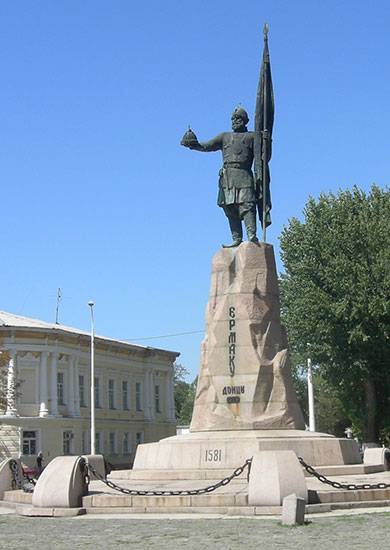
Monument to Yermak Timofeevich in Novocherkassk. Sculptor V. Beklemishev. Opened 6 May 1904
The accession of Siberia was of great political and economic importance. Up to 80's XVI century "Siberian theme" is practically not mentioned in diplomatic documents. However, as Ivan IV received information about the results of Ermak's campaign, she took a firm place in diplomatic documentation. Already by 1584, the documents contain a detailed description of the relationship with the Siberian Khanate, which includes a summary of the main events - the military operations of the ataman Yermak against the troops of Kuchum.
In the middle of 80's. In the 16th century, the colonization flows of the Russian peasantry gradually moved to explore the vast expanses of Siberia, and the fortress built in 1586 and 1587 were not only important strongholds for fighting the Kuchumlians, but also the foundation of the first settlements of Russian grain-growers. The governors sent by the Russian tsars to the harsh in all respects Siberian region could not cope with the remnants of the horde and achieve the conquest of this fertile and politically important region for Russia. However, thanks to the martial art of the Cossack ataman Yermak Timofeevich, already in the 90-s. In the 16th century, Western Siberia was incorporated into Russia.
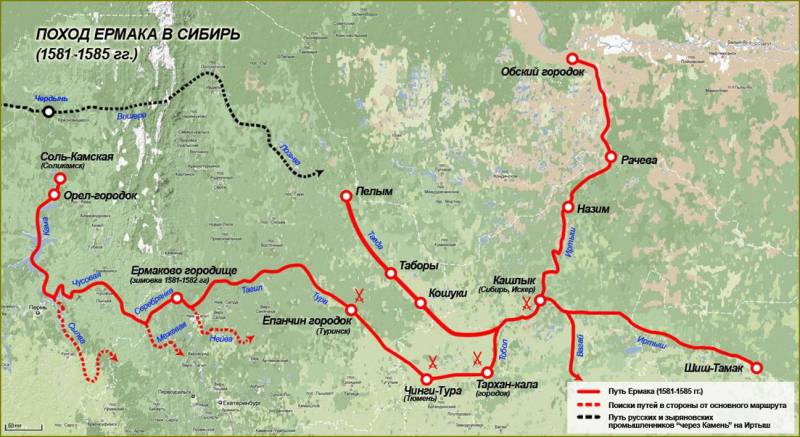
Information